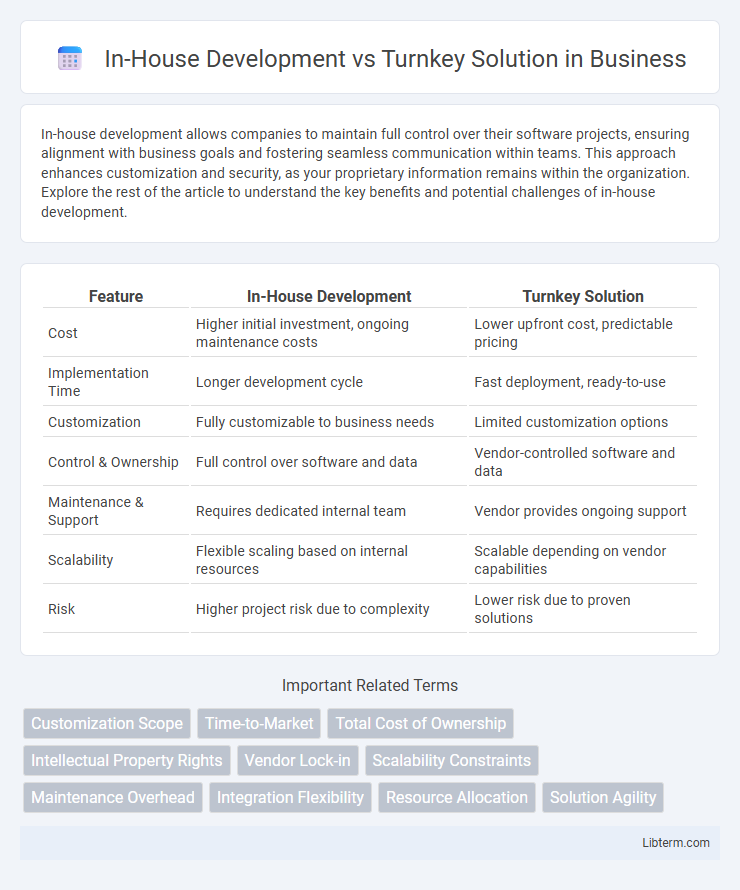In-house development allows companies to maintain full control over their software projects, ensuring alignment with business goals and fostering seamless communication within teams. This approach enhances customization and security, as your proprietary information remains within the organization. Explore the rest of the article to understand the key benefits and potential challenges of in-house development.
Table of Comparison
| Feature | In-House Development | Turnkey Solution |
|---|---|---|
| Cost | Higher initial investment, ongoing maintenance costs | Lower upfront cost, predictable pricing |
| Implementation Time | Longer development cycle | Fast deployment, ready-to-use |
| Customization | Fully customizable to business needs | Limited customization options |
| Control & Ownership | Full control over software and data | Vendor-controlled software and data |
| Maintenance & Support | Requires dedicated internal team | Vendor provides ongoing support |
| Scalability | Flexible scaling based on internal resources | Scalable depending on vendor capabilities |
| Risk | Higher project risk due to complexity | Lower risk due to proven solutions |
Introduction to In-House Development and Turnkey Solutions
In-house development involves creating software or products within an organization's own team, leveraging internal expertise to tailor solutions specifically to company needs. Turnkey solutions provide ready-made products or services that can be quickly implemented without extensive customization, often delivered by third-party vendors. Choosing between in-house development and turnkey solutions depends on factors such as budget, project complexity, timeline, and desired control over the final product.
Defining In-House Development: Pros and Cons
In-house development involves creating software solutions internally within an organization, offering tailored customization and direct control over the development process. Pros include enhanced alignment with business goals, greater flexibility, and the ability to quickly address bugs or changes, while cons involve higher upfront costs, longer development timelines, and the need for skilled personnel. This approach suits companies prioritizing proprietary technology and intellectual property ownership but requires significant internal resources and ongoing maintenance commitments.
Understanding Turnkey Solutions: Key Benefits and Drawbacks
Turnkey solutions offer businesses a fully developed, ready-to-use product that minimizes development time and resource allocation. These solutions provide streamlined implementation and vendor support but may lack customization flexibility, potentially leading to integration challenges. Choosing a turnkey solution requires evaluating its alignment with specific business needs against the trade-offs in adaptability and long-term scalability.
Cost Comparison: In-House vs. Turnkey
In-house development demands significant upfront investment in skilled personnel, infrastructure, and ongoing maintenance, often leading to higher initial costs but greater long-term control and customization. Turnkey solutions offer predictable pricing and faster deployment, reducing immediate expenses but potentially entailing higher recurring fees and limited flexibility. Cost comparison hinges on project complexity, scalability needs, and total cost of ownership over the product lifecycle.
Scalability and Flexibility Considerations
In-house development offers superior scalability by allowing businesses to customize and expand software architecture according to evolving needs without dependency on external vendors. Turnkey solutions provide quicker deployment but often lack the flexibility necessary to adapt to unique or complex workflows as the organization grows. Selecting between in-house and turnkey depends on the priority of long-term scalability and customization versus immediate implementation and standardized functionality.
Speed of Implementation: Which is Faster?
Turnkey solutions offer significantly faster speed of implementation compared to in-house development since they are pre-built, tested, and ready for immediate deployment. In-house development requires extensive time for design, coding, testing, and iteration, often extending project timelines due to resource constraints and unforeseen technical challenges. Companies prioritizing rapid deployment and immediate operational capability frequently opt for turnkey solutions to gain competitive advantage and reduce time-to-market.
Customization Capabilities: Tailored vs. Ready-Made
In-house development offers unmatched customization capabilities, allowing businesses to tailor software solutions specifically to their unique workflows and requirements. Turnkey solutions provide ready-made functionality designed to accommodate common industry needs but often lack the flexibility to adapt extensively to individual business processes. Choosing between these options depends on prioritizing either bespoke customization or rapid deployment with standardized features.
Security and Compliance Factors
In-house development offers granular control over security protocols and compliance measures, enabling tailored solutions aligned with specific regulatory requirements such as GDPR, HIPAA, or PCI-DSS. Turnkey solutions often come with standardized security features and pre-validated compliance certifications, reducing implementation time but potentially limiting customization for unique organizational policies. Evaluating risk tolerance and the need for customized security governance is critical when choosing between in-house development and turnkey solutions.
Maintenance, Support, and Long-Term Viability
In-house development offers direct control over maintenance and tailored support, ensuring rapid issue resolution and alignment with evolving business needs. Turnkey solutions often provide vendor-managed maintenance and support services but may involve dependency risks and less flexibility for customization. Long-term viability favors in-house projects that adapt continuously, whereas turnkey systems rely on vendor stability and update cycles for sustained performance.
Choosing the Right Approach: Key Decision-Making Criteria
Choosing between in-house development and a turnkey solution hinges on factors such as budget constraints, project timeline, and desired customization level. In-house development offers greater control and flexibility but requires significant internal resources and expertise. Turnkey solutions provide faster deployment and lower upfront costs, ideal for standardized needs with limited technical capacity.
In-House Development Infographic

 libterm.com
libterm.com